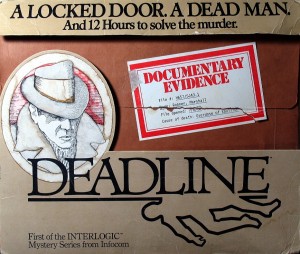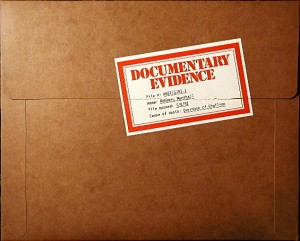We’re now closing in on the end game, tailing our two suspects, Baxter and Dunbar, as they move about the Robner estate. Succeeding at another cat-and-mouse chase lets us observe an urgent, whispered conference between the two inside the garden shed, although we can’t make out the actual words spoken. But that doesn’t matter. We have enough now to ARREST DUNBAR AND BAXTER and win the game. When we do so, Blank gives us the full story in classic Agatha Christie fashion.
Mr. Robner's life was his company, as was attested to by a number of the principals. George knew that Mr. Robner had lost control of the company, and a story in the Daily Herald indicated that Mr. Baxter intended to sell the company to Omnidyne, the multi-national conglomerate, presumably to advance his career. Baxter admitted to the merger plans, but indicated that Mr. Robner was in complete agreement. This is contrary to what George and Mrs. Robner said. The note pad found in the library was Robner's last, desperate attempt to save the company, in which Robner threatened to expose Baxter's involvement in the 'Focus' scandal, whose details are unclear. Baxter denied getting the note, but it was not in the trash. The papers detailing Baxter's criminality in the scandal were kept locked in a safe in a hidden closet near the library. Only George and Robner knew the whereabouts and the combination to the safe.
Baxter planned to murder Robner, playing on the fact that Robner was known to be depressed, even suicidal. He enlisted the help of his lover, Ms. Dunbar, one of whose medicines was found to interact fatally with the medicine Robner was taking. Clearly the relationship of Baxter and Dunbar was kept quiet, although Mrs. Rourke had an inkling of it. After the concert at the Hartford Philharmonic, which both Baxter and Dunbar attended, they returned to the Robner estate. Dunbar placed some LoBlo in Robner’s tea, and Robner died some time later. Baxter, using the ladder from the shed, entered the library after Robner had died and exchanged the incriminating cup for a clean one (counting the cups and saucers in the kitchen reveals that a cup is missing). Coming down the ladder, Baxter presumably dropped the cup and inadvertently left one piece on the ground in the rose garden, nearby where Mr. McNabb found the ladder holes while tending to his roses.
If we fail to arrest Baxter and Dunbar immediately after their conference, he, fearing she is about to confess, goes up to her room and shoots her, then tries to make it look like a suicide (obviously something of a standard modus operandi for him). After that we can only clean up the damage as best we can; at least we can, if we’ve collected sufficient evidence, now arrest him for two murders instead of one. Indeed, and while the full solution is damnably difficult to get to, Deadline does allow for partial success (or failure, depending on how you look at it). It features quite a number of different possible endings. Blank saw this as key to the new adventure paradigm it represented, and a remedy to his biggest frustration with the Wheatley crime dossiers. From a contemporary article in Softline:
Reading the old game books [the Wheatley dossiers], he knew he was on to something, except that at the end, the solution packet was not able to say, “No, you’re wrong; try again”; it simply gave you the answer. It was not interactive.
“We wanted to come up with something where you have action/reaction,” Blank recalls, “where you’re told the part that you’ve missed after you come up with a potential solution, and you can go back and try again.”
Of course, given the game’s legendary difficulty players would be trying again many, many times. In addition to that dodgy rose-garden puzzle, I believe we can point to three factors that make Deadline so hard to crack, perhaps sometimes unintentionally so.
One factor is the very dynamic nature of this storyworld, the same thing that made Deadline so innovative. By having things happen of their own accord, Deadline makes it all too easy to miss those things without even realizing anything ever occurred at all. What happens, for instance, if the player happens to be outside when the phone rings? In trying to craft an adventure that felt more like a real story, Blank ran somewhat afoul of something I’ll call “story logic”: many times in stories the protagonist simply happens to be in the right place at the right time. In a sense the player of Deadline must recreate this story logic, by carefully plotting out the movements of the world around her over many failed plays to deduce where the protagonist needs to miraculously be and when. Whether this is always, absolutely unfair is debatable. It obviously falls into the prohibition against needing “knowledge from past lives” in Graham Nelson’s Player’s Bill of Rights, but if we come to it understanding what kind of rules it’s guided by it can be very rewarding to plot out and crack as a system. This is the puzzle-box mode of play, of coming to understand the game as a system and then devising a plan to guide it where you will.
Another, less positive contributor to Deadline‘s difficulty is that it’s very difficult to know where your investigation really stands much of the time. For example, when two suspects contradict one another, as did Baxter and Dunbar there at the end, that often counts as evidence that will weigh into the final verdict after you make your arrest(s). Yet it’s very difficult to determine what the program considers important and what it does not. Nor is there any way to tell whether you have enough to arrest someone without just trying it and seeing what happens. It all leads to a constant feeling of uncertainty and confusion, not just about the case (which is to be expected), but about just what the program knows about the case. Similar problems often dog even modern mystery implementations, although the opacity could be remedied greatly in a modern reimplementation of Deadline by a simple status screen with progress bars showing the progress of evidence collection. But Infocom didn’t have the resources to spare for such niceties.
Lastly, and least positively, there is a constant smattering of low-level bugginess, especially in the early releases of Deadline. It’s much, much harder to debug a dynamic system like Deadline than it was earlier, more static adventures, and Infocom’s QA processes were not yet what they would be in years to come. Sometimes this just leads to amusing oddities, like the “quantity of Scotch” you can pour out of the bottle and carry around with you. Other times it makes you kind of nervous as a player, uncertain whether you can entirely trust Deadline as a system, as when triggers don’t seem to fire and characters don’t react like you expect them to. In this new mode of play which Deadline represents, which absolutely depends on the game being a consistent and logical construct, such distrust can be deadly to the experience. The inconsistencies are perhaps not even entirely down to bugs, but at least in one case seem more the result of a certain authorial laziness. In the climax, it seems that Baxter simply teleports into Dunbar’s room to kill her rather than walking there, a stark violation of the game’s otherwise staunch commitment to realism. (I believe this at least was corrected in later versions.) At best, it all adds to that certain player uneasiness described in the previous paragraph. At worst, it destroys the player’s faith in the game as a solvable, consistent system.
In addition to the outright bugs, there are a million ways in which the game fails as fiction, most coming down, predictably enough, to character interaction. It’s possible to ask the same person about the same thing over and over, with the same response; to talk about one character with another while both are in the same room; to burst in on people in their bedroom or even bathroom without them seeming to notice or care. Still, given how difficult these problems still are for us even today, and given the game’s age and the technology on which it ran, it seems silly to quibble too much about this sort of thing.
No, better to talk about the strange fascination this dynamic little story-system still manages to inspire. Many who never managed to beat it nevertheless speak of it with a certain awe. Emily Short hit on some of its appeal with her review on the Interactive Fiction Database:
What captured my imagination then, and still has a certain appeal, is the recurring sense of excitement from observing without being observed: listening in on phone extensions, looking for secret rooms, following people. There was always the sense that important and significant secrets were hidden under every surface.
That sense of being thrust into an unfolding story was unheard of in adventure games prior to Deadline. Blank, from Softline again:
“In Deadline, we wanted to appeal to the nonfantasy people who would rather be part of a real story; people who always wanted to participate when they read the books. We designed the game to be open-ended and to have a large vocabulary, but at the same time, we didn’t want it too large and too open.”
Deadline demonstrates the first inklings of a deep rather than broad philosophy of design, in which the storyworld is more compact and focused, but filled with more possibilities for interaction and a deeper commitment to mimesis and realism. Few others were thinking about design on this level in 1982.
As something genuinely new under the adventuring sun, Deadline was greeted with great excitement. It became a deservedly major hit for Infocom, selling almost 25,000 copies in the last eight months of 1982 alone and helping to cement the company’s growing reputation as the most sophisticated and adult of adventure publishers. Today it stands as one of the most important of all the company’s games for its many formal innovations.
Next time I want to talk just a bit more about Infocom before we shift to something else for a while…











